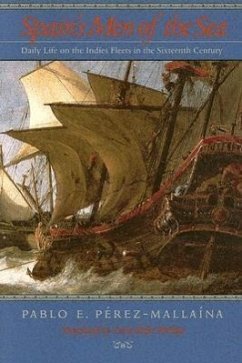In the sixteenth century, Spain's control over its vast New World empire depended on the sailors and officers who manned the galleons and merchant vessels of its Atlantic fleets. In Spain's Men of the Sea, Pablo E. Prez-Mallana paints a stunning portrait of daily life aboard the ships of the Spanish Main. With a novelist's eye for both detail and drama, Prez-Mallana evokes the golden age of seafaring in this thoroughly researched and generously illustrated account. Spain's Men of the Sea begins in Seville, the gateway to the New World. One of Europe's most cosmopolitan cities, Seville attracted people and goods from around the world. From Seville, Prez-Mallana follows the Spanish fleets to the West Indies ports of San Juan de Ulda, Veracruz, Cartagena, Nombre de Dios, Portobelo, and Havana. He profiles the men and boys who went to sea -- from the scions of seafaring dynasties and fugitives from justice to the orphans and destitute children apprenticed into service as cabin boys. Some signed on because of family tradition, more signed on because of the lure of New World treasure or simply to obtain free passage to the Americas. Most sailors were poorly paid, but the more enterprising among them supplemented their meager wages by small-scale trade or smuggling. Prez-Mallana also describes relations among the ship owners, officers, and crews, and traces the intervention of the Spanish government in disputes over pay and cases of insubordination and mistreatment. Prez-Mallana paints a bleak picture of life at sea and its physical and mental effect on seamen and passengers alike. The seafaring life was defined by cramped quarters, abominable food, seasickness, vermin infestation, anddisease. More frightening still was the threat of shipwreck and assault by corsairs and pirates that accompanied all sea voyages. Not surprisingly, most sailors were highly superstitious, and Prez-Mallana closes his vivid study with an exploration of their unorthodox religious








